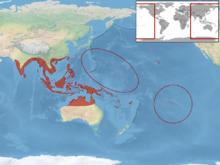Common house gecko
| Common house gecko | |
|---|---|
 |
|
| Hemidactylus frenatus | |
| Scientific classification | |
| Kingdom: | Animalia |
| Phylum: | Chordata |
| Class: | Reptilia |
| Order: | Squamata |
| Family: | Gekkonidae |
| Genus: | Hemidactylus |
| Species: | H. frenatus |
| Binomial name | |
|
Hemidactylus frenatus Schlegel, 1836 |
|
 |
|
The common house gecko (Hemidactylus frenatus) (not to be confused with the Mediterranean species Hemidactylus turcicus known as Mediterranean house gecko), is a reptile native of Southeast Asia. It is also known as the Pacific house gecko, the Asian house gecko, house lizard, or Moon Lizard.
Most geckos are nocturnal, hiding during the day and foraging for insects at night. They can be seen climbing walls of houses and other buildings in search of insects attracted to porch lights, hence their name "house gecko". Spread around the world by ships, these geckos are now common in the Deep South of the United States, large parts of tropical and sub-tropical Australia, and many other countries in South and Central America, Africa, South Asia, and the Middle East. They grow to a length of between 75–150 mm (3–6 in), and live for about 5 years. These small geckos are non-venomous and harmless to humans. Medium to large geckos may bite if distressed, however their bite is gentle and will not pierce skin.
A tropical gecko, Hemidactylus frenatus thrives in warm, humid areas where it can crawl around on rotting wood in search of the insects it eats. The animal is very adaptable and may prey on insects and spiders, displacing other reptiles.
Like many geckos, this species can lose its tail when alarmed. Its call or chirp rather resembles the sound "gecko, gecko". However, this is an interpretation, and the sound may also be described as "tchak tchak tchak" (often sounded three times in sequence). In Asia/Southeast Asia, notably Indonesia, Thailand, Singapore, and Malaysia, geckos have local names onomatopoetically derived from the sounds they make: Hemidactylus frenatus is called "chee chak" or "chi chak" (pr- chee chuck), said quickly. Also commonly spelled as "cicak" in Malay dictionaries. In the Philippines they are called "butiki" in Tagalog, or "tiki" in Visayan, and in Thailand "jing-jok" (Thai: จิ้งจก). In Myanmar, they are called "အိမ်မြှောင် - ain-mjong" ( "အိမ် - ain" means "house" and "မြှောင် - mjong" means "stick to"). In some parts of India and in Pakistan they are called "chhipkali" (Urdu:چہپکلی, Hindi: छिपकली), from chhipkana, to stick. In Nepal they are called "bhitti" (Nepali: भित्ती) or "mausuli" (Nepali: माउसुली). In other parts of India they are called "jhiti piti" (Oriya: ଝିଟିପିଟି), "thikthikiaa" (Maithili: ठिकठिकिया), "paal" (Marathi: पाल), "gawli" or "palli" (Malayalam: ഗവ്ളി (gawli), പല്ലി (palli), Tamil: பல்லி (palli)), Telugu: బల్లి (balli), Kannada: ಹಲ್ಲಿ (halli). In West Bengal and Bangladesh they are called "tiktiki" (Bengali: টিকটিকি) as the sound is perceived as "tik tik tik". In Sri Lanka they are called "huna" in singular form (Sinhalese: හුනා). In Central America they are sometimes called "Limpia Casas" (Spanish: Housecleaners) because they reduce the amount of insects and other arthropods in homes.
...
Wikipedia
